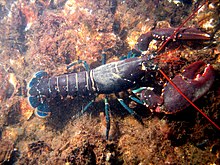
Back Loppestre ANG كركند Arabic كركند ARZ Llagosta AST Banagan BCL Амары Byelorussian Амары BE-X-OLD Омари Bulgarian গলদা Bengali/Bangla Nefròpids Catalan
| Lobster Temporal range:
| |
|---|---|

| |
| European lobster (Homarus gammarus) | |
| Scientific classification | |
| Domain: | Eukaryota |
| Kingdom: | Animalia |
| Phylum: | Arthropoda |
| Class: | Malacostraca |
| Order: | Decapoda |
| Suborder: | Pleocyemata |
| Superfamily: | Nephropoidea |
| Family: | Nephropidae Dana, 1852 |
| Genera[1] | |
|
List
| |
| Synonyms[2] | |
| |

Lobsters are malacostracans of the family Nephropidae[1] or its synonym Homaridae.[2] They have long bodies with muscular tails and live in crevices or burrows on the sea floor. Three of their five pairs of legs have claws, including the first pair, which are usually much larger than the others. Highly prized as seafood, lobsters are economically important and are often one of the most profitable commodities in the coastal areas they populate.[3]
Commercially important species include two species of Homarus from the northern Atlantic Ocean and scampi (which look more like a shrimp, or a "mini lobster")—the Northern Hemisphere genus Nephrops and the Southern Hemisphere genus Metanephrops.[citation needed]
- ^ a b Sammy De Grave; N. Dean Pentcheff; Shane T. Ahyong; et al. (2009). "A classification of living and fossil genera of decapod crustaceans" (PDF). Raffles Bulletin of Zoology. Suppl. 21: 1–109. Archived from the original (PDF) on June 6, 2011.
- ^ a b Poore, Gary C. B. (2016). "The Names of the Higher Taxa of Crustacea Decapoda". Journal of Crustacean Biology. 36 (2): 248–255. Retrieved March 23, 2022.
- ^ "Homarus americanus, American lobster" (PDF). McGill University. June 27, 2007. Archived (PDF) from the original on July 6, 2011.